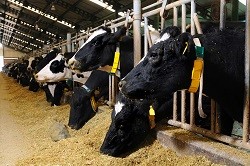Laying down a marker for efficient cattle production
Growing demand for meat and milk, fuelled by an expanding and increasingly affluent global population, is placing a significant strain on our natural resources. Livestock are a major source of greenhouse gas emissions and waste, and require significant amounts of land for growing feed crops. ‘The extent to which grain is currently used in the feeding of ruminants is not sustainable,’ agrees MARKEFFICIENCY project coordinator Diego Morgavi from the Institut National De La Recherche Agronomique (INRA) in France. ‘A key point that is often missed is that ruminants have a capacity for digesting cellulosic substrates that we humans cannot eat and convert into energy. Naturally occurring microbes help cattle convert forage into the high levels of protein and essential micronutrients found in meat and milk. Transitioning to a foraging-based diet would actually be very efficient as you get more human-edible energy and protein from the animal than you put in.’ Reducing environmental impact of cattle The goal of the MARKEFFICIENCY project was therefore to develop ways of encouraging this switch from grain to forage-based diets in cattle. This was achieved by exploring potential biomarkers of feed efficiency in cattle fed forage-based diets. ‘These could then be used to effectively measure and rank this trait in young animals,’ explains Morgavi. ‘Being able to select the most efficient animals and formulate diets according to animal potential would benefit farmers economically, while at the same time help to reduce the environmental impact of ruminants.’ The study combined multiple sample types – blood, plasma, hair, faeces and carcass – as well as numerous different analytical techniques, including near infrared spectrometry (NIRS) and mass spectrometry. These were used to identify promising biomarkers for the two primary metrics of feed efficiency – residual feed intake and feed conversion efficiency. This approach also gave Morgavi and his team an insight into the factors behind divergent feed efficiencies in growing cattle. Many of these techniques had not been previously used for tackling feed efficiency. For example, the use of easily obtainable samples of hair for the determination of nitrogen isotopic discrimination, and the exploration of plasma as a biomarker for feed efficiency using NIRS, have not been previously explored. Similarly, the methods used to quantify vitamins B2 and B6 were developed specifically for this project, providing novel information that Morgavi hopes can be adopted in future research. ‘This project also has real practical applications,’ says Morgavi. ‘For example we are located in a mountainous area of France, where cattle farmers face major challenges from land constraints. Feeding our cattle with as much forage as possible makes sense.’ Tackling methane emissions The project also explored the possibility of modulating the microbial community in ruminants early in life, in order to reduce methane emissions. ‘Every mammal acquires microbiota when it is born; in fact colonisation begins immediately after and perhaps during birth,’ explains Marie Curie Fellowship recipient Sarah Meale, who worked with Morgavi at INRA on this project. ‘We wanted to know what would happen if we modified this early implantation, and whether we could reduce the carbon footprint of cattle.’ While the team is cautiously optimistic that this approach might yield positive results, Morgavi stresses that it is too early to draw conclusions. ‘We know that the microbial community can be modulated early in life, but these tests will now have to be repeated again and again,’ he says.
Keywords
MARKEFFICIENCY, biomarkers, microbiota, cattle, emissions

